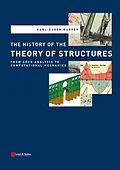Das vorliegende Buch zeichnet die Entstehung von Statik und Festigkeitslehre als die Entwicklung vom geometrischen Denken der Renaissance zur durch die klassische Mechanik begründeten technikwissenschaftlichen Grundlagendisziplin nach. Beginnend mit den Festigkeitsbetrachtungen von Leonardo und Galilei wird der Herausbildung einzelner baustatischer Verfahren und ihrer Formierung zur Baustatik im 19. Jahrhundert nachgegangen. Erstmals wird eine zusammenfassende Darstellung der Entwicklung von der klassischen Baustatik zur Strukturmechanik und Computational Mechanics im letzten Jahrhundert geboten. Dabei gelingt es dem Autor, die Unterschiedlichkeit der Akteure hinsichtlich ihres technisch-wissenschaftlichen Profils und ihrer Persönlichkeit plastisch zu schildern und das Verständnis für den gesellschaftlichen Kontext zu erzeugen. Kurze, durch historische Skizzen unterstützte Einblicke in gängige Berechnungsverfahren erleichtern den Zugang zur Geschichte der Strukturmechanik vom heutigen Stand der Ingenieurpraxis. 175 Kurzbiographien bedeutender Bauingenieure und Strukturmechaniker sowie eine umfangreiche Bibliographie runden das Werk ab.
Autorentext
Dr.-Ing. Karl-Eugen Kurrer has been chief editor of the journal "Stahlbau", published by Ernst & Sohn, Berlin, since 1996. His interest in the history of theory of structures from the scientific and engineering perspectives began some 30 years ago. The great success of his book "Geschichte der Baustatik" published at the end of 2002, the repeated requests for an English edition and the members of the Berlin-based VDI History of Engineering Study Group inspired him to write this revised edition.
Zusammenfassung
This book traces the evolution of theory of structures and strength of materials - the development of the geometrical thinking of the Renaissance to become the fundamental engineering science discipline rooted in classical mechanics. Starting with the strength experiments of Leonardo da Vinci and Galileo, the author examines the emergence of individual structural analysis methods and their formation into theory of structures in the 19th century. For the first time, a book of this kind outlines the development from classical theory of structures to the structural mechanics and computational mechanics of the 20th century. In doing so, the author has managed to bring alive the differences between the players with respect to their engineering and scientific profiles and personalities, and to create an understanding for the social context. Brief insights into common methods of analysis, backed up by historical details, help the reader gain an understanding of the history of structural mechanics from the standpoint of modern engineering practice. A total of 175 brief biographies of important personalities in civil and structural engineering as well as structural mechanics plus an extensive bibliography round off this work.
Inhalt
Zum Geleit von Prof. Ekkehard Ramm
Vorwort
Vorwort zur ersten deutschen Auflage
Aufgaben und Ziele der Historiographie der Baustatik
Lernen aus der Geschichte: Elf Einführungsvorträge in die Baustatik
Die ersten technikwissenschaftlichen Grundlagendisziplinen: Baustatik und Technische Mechanik
Vom Gewölbe zum Bogen
Die Anfänge der Baustatik
Die Disziplinbildungsperiode der Baustatik
Vom Eisenbau zum modernen Stahlbau
Die Stabstatik erobert die dritte Dimension: Das Raumfachwerk
Der Einfluss des Stahlbetonbaus auf die Baustatik
Von der klassischen zur modernen Baustatik
Zwölf wissenschaftliche Kontroversen in der Mechanik und Baustatik
Perspektiven der Baustatik
Kurzbiographien
Bibliographie
Personenregister
Sachregister
